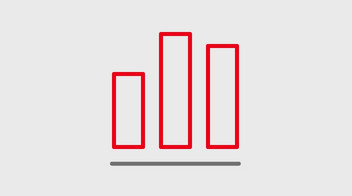Development in the year under review
- Overall, a very challenging market environment and a lack of economic stimulus.
- Operating profit figures, driven by air and ocean freight and contract logistics, continue to be significantly above the pre-Covid-19 level.
- Comprehensive measures to improve efficiency and digitalization have been implemented.
DB Schenker | 2023 | 2022 | Change | |
absolute | % | |||
Customer satisfaction (grade) | 2.2 | 2.5 | –0.3 | – |
Land transport shipments (million) | 100.8 | 102.8 | –2.0 | –1.9 |
Air freight volume (export) (thousand t) | 1,148 | 1,326 | –178 | –13.4 |
Ocean freight volume (export) (thousand TEU) | 1,783 | 1,909 | –126 | –6.6 |
Total revenues (€ million) | 19,127 | 27,604 | –8,477 | –30.7 |
External revenues (€ million) | 19,104 | 27,545 | –8,441 | –30.6 |
Gross profit margin (%) | 40.9 | 30.9 | +10.0 | – |
EBITDA adjusted (€ million) | 1,909 | 2,512 | –603 | –24.0 |
EBIT adjusted (€ million) | 1,129 | 1,841 | –712 | –38.7 |
EBIT margin (adjusted) (%) | 5.9 | 6.7 | –0.8 | – |
Gross capital expenditures (€ million) | 950 | 946 | +4 | +0.4 |
Employees as of Dec 31 (FTE) | 72,710 | 76,591 | –3,881 | –5.1 |
| Employees annual average (FTE) | 75,062 | 75,907 | –845 | –1.1 |
Employee satisfaction (SI) | – | 4.0 | – | – |
Share of women as of Dec 31 (%) | 36.4 | 36.7 | –0.3 | – |
Specific CO₂e emissions (land transport) compared to 2006 (based on tkm) 1), 2) (%) | –29.4 | –29.4 | ‒ | – |
Specific CO₂e emissions (air freight) compared to 2006 (based on tkm) 2) (%) | –15.5 | –16.2 | +0.7 | – |
Specific CO₂e emissions (ocean freight) compared to 2006 (based on tkm) 2) (%) | –66.7 | –67.2 | +0.5 | – |
1) Excluding USA Truck.
2) Specific CO₂ emissions in 2022.
A survey with about 10,000 respondents from 16 countries is used to assess customer satisfaction. This survey is conducted annually. Customer satisfaction increased significantly in 2023.
The volume trend declined overall. The driver was generally weak market development as a result of a lack of economic stimulus.
Economic development, driven by air and ocean freight, was considerably weaker: operating profit figures declined in all regions, but remained well above the pre-Covid-19 level. Accordingly, gross profit also declined (–8.3%). Adjusted for exchange rates, the decline was even greater.
Income development was weaker due to the considerable decline in revenues:
- Revenues (–30.7%/€ –8,477 million): Significant decline as a result of lower freight rates, particularly in air and ocean freight, as well as due to demand. Exchange rate effects also reduced revenues.
- Other operating income (+28.0%/€ +74 million): Significant increase due, among other things, to higher income from the release of provisions and the disposal of fixed assets. Adjusted for exchange rate effects, the increase was even greater.
Expenses were driven mainly by freight-rate developments. The effects of measures to improve productivity also had a positive effect:
- Cost of materials (–40.2%/€ –7,742 million): Significant decline as a result of freight-rate developments, particularly in air and ocean freight, as well as exchange rate effects.
- Personnel expenses (–0.8%/€ –33 million): Slight decline. Efficiency measures, which led to a lower average number of employees, as well as exchange rate effects, were largely offset by higher personnel costs due to inflation.
- Other operating expenses (–1.2%/€ –24 million): Also a slight decline, mainly due to lower insurance expenses and reduced service activities for performance-related reasons. Exchange rate effects had a supporting effect.
- Depreciation (+16.2%/€ +109 million): Increase mainly due to effects in connection with the acquisition of USA Truck. Adjusted for exchange rate effects, the increase was even greater.
Capital expenditures were roughly at the previous year’s level. The capital expenditure priorities were the Europe, America and Asia regions.
The number of employees fell as a result of operational business development, efficiency measures and the conclusion of the integration of USA Truck.
The proportion of female employees fell slightly.
The development of specific CO₂e emissions compared to the reference year 2006 was at a similar level in 2023 as in the previous year.
- Land transport: The decline in specific emissions compared to the reference year 2006 remained stable compared to the previous year. Improvements were offset by lower utilization of the land transport network.
- Air freight: Air transport recorded a slight drop in efficiency in terms of CO₂e emissions. This was mainly due to the noticeable decline in volume.
- Ocean freight: Efficiency in ocean freight in terms of CO₂e emissions has also declined slightly. Progress was made through the use of biofuel. However, these were more than offset by the noticeable decline in volume.
Land transport line of business
- The declining shipment volume for domestic shipments was compensated for by pricing measures.
- Portfolio optimization and quality improvements with positive effects.
- Further promoting digital transformation and optimizing the product and customer mix, the network and a more sustainable product range.
Land transport line of business | 2023 | 2022 | Change | |
absolute | % | |||
Land transport shipments (million) | 100.8 | 102.8 | –2.0 | –1.9 |
Total revenues (€ million) | 7,852 | 7,852 | – | – |
External revenues (€ million) | 7,837 | 7,832 | +5 | +0.1 |
EBITDA adjusted (€ million) | 481 | 399 | +82 | +20.6 |
EBIT adjusted (€ million) | 140 | 158 | –18 | –11.4 |
Employees as of Dec 31 (FTE) | 23,738 | 24,706 | –968 | –3.9 |
Demand for land transport dropped, driven by declines in system freight traffic. Uncertainties regarding economic development, inflation and the effects of the war in Ukraine were the main drivers. Conversely, the shipment volume in parcel and direct freight traffic increased.
Economic development, on the other hand, was improved.Adjusted EBITDA increased noticeably as a result of lower expenses. In contrast, the increase in depreciation as a result of a one-off effect led to a decline in adjusted EBIT.
- The increase in income resulted mainly from effects in connection with the disposal of property, plant and equipment. Revenues were roughly at the previous year’s level. Effects from generally increased sales prices and positive exchange rate effects were almost completely eliminated by declines in demand.
- Expenses fell disproportionately due to a performance-related reduction in cost of materials. This was partly counteracted by significantly higher personnel expenses (mainly an increase in the average number of employees and as a result of collective bargaining agreements) and higher depreciation (effects in connection with the acquisition of USA Truck).
The number of employees fell, due in part to the business development and the conclusion of the integration of USA Truck.
Air and ocean freight line of business
- Decline in demand due to weak market momentum. Negative development slowed in the second half of 2023.
- Rising capacities and economic uncertainties shaped development – countermeasures had positive effects.
- Significant decline in freight rates – rates in ocean freight back to pre-Covid-19 levels.
- Air freight: implementation of projects to improve efficiency and stabilize profitability.
- Ocean freight: business recovery in trade fairs and major projects, which were under pressure due to Covid-19.
Air and ocean freight line of business | 2023 | 2022 | Change | |
absolute | % | |||
Air freight volume (export) (thousand t) | 1,148 | 1,326 | –178 | –13.4 |
Ocean freight volume (export) (thousand TEU) | 1,783 | 1,909 | –126 | –6.6 |
Total revenues (€ million) | 8,535 | 16,530 | –7,995 | –48.4 |
External revenues (€ million) | 8,529 | 16,521 | –7,992 | –48.4 |
EBITDA adjusted (€ million) | 852 | 1,575 | –723 | –45.9 |
EBIT adjusted (€ million) | 771 | 1,503 | –732 | –48.7 |
Employees as of Dec 31 (FTE) | 12,844 | 14,204 | –1,360 | –9.6 |
Performance development saw a significant decline:
- Air freight: Negative effects, mainly due to weak market momentum due to inflation, were only partially offset.
- Ocean freight: As a result of market developments, volumes were also significantly below the previous year’s level. The reduction in inventories had a supporting effect.
Economic development was significantly weaker: the adjusted profit figures declined again after the extraordinarily high increases in previous years, but remained very much above the pre-Covid-19 level.
- The main driver of the significant decline in income was the decline in revenues as a result of freight rate and performance development.
- Air freight trends from the end of the previous year continued. Rising capacities and declining demand led to a drop in the freight rate level, putting pressure on prices for new contracts.
- High capacities and declining demand also led to significantly lower freight rates in ocean freight. Adjusted for exchange rate effects, the revenue decline was even more pronounced.
- The decline in expenses was disproportionate and resulted mainly from the development of freight rates and lower demand. Adjusted for exchange rate effects, the decline was even more pronounced. Personnel expenses (due to a lower number of employees) and other operating expenses (due to the lower volume) also fell.
Declining volume development and the associated lower shipment figures led to a reduction in the number of employees.
Contract logistics line of business
- Revenue development declined in a difficult market environment.
- Measures to improve productivity and profitability with positive contribution to profits.
- Operating profit figures improved.
- The acquisition of new business was very satisfactory.
Contract logistics line of business | 2023 | 2022 | Change | |
absolute | % | |||
Warehouse space (million m²) | 8.5 | 8.6 | –0.1 | –1.2 |
Total revenues (€ million) | 2,741 | 3,195 | –454 | –14.2 |
External revenues (€ million) | 2,739 | 3,193 | –454 | –14.2 |
EBITDA adjusted (€ million) | 500 | 455 | +45 | +9.9 |
EBIT adjusted (€ million) | 212 | 166 | +46 | +27.7 |
Employees as of Dec 31 (FTE) | 21,661 | 22,101 | –440 | –2.0 |
The sales of MTS and EVAG limited the comparability with the previous year.
Contract logistics generally developed positively thanks to the portfolio, which is diversified both geographically and by market sector.
The economic development was very satisfying in a challenging market environment. Adjusted profit figures rose, driven by a decrease in expenses:
- The decline in income was driven by lower revenues and resulted mainly from the sales of MTS and EVAG as well as the intra-business-unit transfer of individual activities in Germany. Adjusted for these effects, there was a stable development, mainly as a result of business development in Europe and America. In particular, positive exchange rate effects and effects from the release of provisions had an offsetting effect on income.
- The disproportionately high decrease in expenses was mainly due to the sale of MTS and EVAG. In addition, lower cost of materials (ending cost-intensive projects) and personnel expenses (lower number of employees) also had a cost-reducing effect. Other operating expenses also fell (due to a lower number of temporary workers). Adjusted for exchange rate effects, the decline was even more pronounced.
The number of employees fell slightly, due in part to higher productivity.


